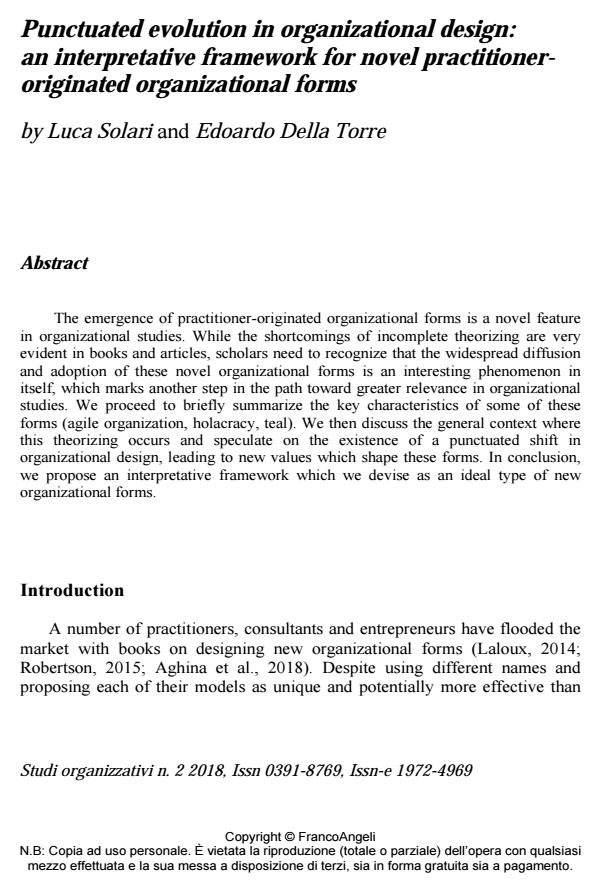Punctuated evolution in organizational design: an interpretative framework for novel practitioneroriginated organizational forms
Titolo Rivista STUDI ORGANIZZATIVI
Autori/Curatori Luca Solari, Edoardo Della Torre
Anno di pubblicazione 2019 Fascicolo 2018/2 Lingua Inglese
Numero pagine 26 P. 177-202 Dimensione file 272 KB
DOI 10.3280/SO2018-002008
Il DOI è il codice a barre della proprietà intellettuale: per saperne di più
clicca qui
Qui sotto puoi vedere in anteprima la prima pagina di questo articolo.
Se questo articolo ti interessa, lo puoi acquistare (e scaricare in formato pdf) seguendo le facili indicazioni per acquistare il download credit. Acquista Download Credits per scaricare questo Articolo in formato PDF

FrancoAngeli è membro della Publishers International Linking Association, Inc (PILA)associazione indipendente e non profit per facilitare (attraverso i servizi tecnologici implementati da CrossRef.org) l’accesso degli studiosi ai contenuti digitali nelle pubblicazioni professionali e scientifiche
The emergence of practitioner-originated organizational forms is a novel feature in organizational studies. While the shortcomings of incomplete theorizing are very evident in books and articles, scholars need to recognize that the widespread diffusion and adoption of these novel organizational forms is an interesting phenomenon in itself, which marks another step in the path toward greater relevance in organizational studies. We proceed to briefly summarize the key characteristics of some of these forms (agile organization, holacracy, teal). We then discuss the general context where this theorizing occurs and speculate on the existence of a punctuated shift in organizational design, leading to new values which shape these forms. In conclusion, we propose an interpretative framework which we devise as an ideal type of new organizational forms.
- Aghina, W., Smet, A.D., Lackey, G., Lurie, M., Murarka, M. (2018), “The five trademarks of agile organizations | McKinsey & Company”, available at: https://www.mckinsey.com (accessed 10 March 2018).
- Baker, W., Nohria, N., Eccles, R.G. (1992), “The network organization in theory and practice”, in Shafritz, J.M., Ott, J.S. and Jang, Y.S., (2015), Classics of organization theory. Cengage Learning, 401-411.
- Baldwin, C.Y., Woodard, C.J. (2009), “The architecture of platforms: A unified view”, Platforms, Markets and Innovation, 19–44.
- Barnard, C.I. (1938), The Functions of the Executive, Harvard University Press.
- Broeck, A., Vansteenkiste, M., Witte, H., Soenens, B., Lens, W. (2010), “Capturing autonomy, competence, and relatedness at work: Construction and initial validation of the Work-related Basic Need Satisfaction scale”, Journal of Occupational and Organizational Psychology, 83(4): 981–1002.
- Cappelli, P. (2008), “Talent management for the twenty-first century”, Harvard Business Review, 86(3): 74.
- Carlzon, J. (1989), Moments of Truth, Reprint edition., HarperBusiness, New York.
- Greenwood, R., Miller, D. (2010), “Tackling Design Anew: Getting Back to the Heart of Organizational Theory”, The Academy of Management Perspectives, 24(4): 78–88.
- Hoffman, R., Casnocha, B., Yeh, C. (2014), The Alliance: Managing Talent in the Networked Age, Harvard Business Review Press.
- Inglehart, R. (2015), The Silent Revolution: Changing Values and Political Styles Among Western Publics, Princeton University Press.
- Inglehart, R., Welzel, C. (2010), “Changing mass priorities: The link between modernization and democracy”, Perspectives on Politics, 8(2): 551–567.
- Ismail, S. (2014), Exponential Organizations: Why New Organizations Are Ten Times Better, Faster, and Cheaper than Yours (and What to Do about It), Diversion Books.
- Laloux, F. (2014), Reinventing Organizations: A Guide to Creating Organizations Inspired by the next Stage in Human Consciousness, Nelson Parker.
- Lawler, E.E. (1988), “Substitutes for hierarchy”, Organizational Dynamics, 17(1): 5–15.
- Lawrence, P.R., Lorsch, J.W. (1967), “Differentiation and integration in complex organizations”, Administrative Science Quarterly, 1–47.
- Lusch, R.F., Vargo, S.L. (2014), Service-Dominant Logic: Premises, Perspectives, Possibilities, Cambridge University Press, Cambridge.
- Nonaka, I., Takeuchi, H. (1995), The Knowledge-Creating Company: How Japanese Companies Create the Dynamics of Innovation, 1 edition., Oxford University Press, New York.
- Orpen, C. (1994), “The effects of organizational and individual career management on career success”, International Journal of Manpower, 15 (1): 27–37.
- Parker, G.G., Alstyne, M.W.V., Choudary, S.P. (2017), Platform Revolution: How Networked Markets Are Transforming the Economy and How to Make Them Work for You, 1 edition., W. W. Norton & Company, New York London.
- Rea, A., Fischer, A., du Rose, J. (2018), “COLONY, Technical White Paper”, available at: https://colony.io/whitepaper.pdf.
- Robertson, B.J. (2015), Holacracy: The Revolutionary Management System That Abolishes Hierarchy, Penguin UK.
- Ruef, M. (2000), “The Emergence of Organizational Forms: A Community Ecology Approach”, American Journal of Sociology, 106(3): 658–714.
- Ryan, R.M., Deci, E.L. (2000), “Self-determination theory and the facilitation of intrinsic motivation, social development, and well-being”, American Psychologist, 55(1): 68–78.
- Senge, P.M. (2006), The Fifth Discipline: The Art and Practice of the Learning Organization, Broadway Business.
- Simmel, G. (1972), Georg Simmel on Individuality and Social Forms, edited by Levine, D.N., University Of Chicago Press.
- Solari, L. (2016), Freedom Management. How Leaders Can Stay Afloat in the Sea of Social Connections, Gower Ashgate.
- Solari, L., Zanon, A. (2001), La quasi fine della gerarchia. Organizzazioni come vantaggio competitivo nella new economy, FrancoAngeli, Milano.
- Stinchcombe, A.L. (1965), “Social Structure and Organizations”, Handbook of Organizations, Rand McNally, Chicago, 142–193.
- Sutherland, J., Sutherland, J.J. (2014), Scrum: The Art of Doing Twice the Work in Half the Time, 1st edition., Currency, New York.
Luca Solari, Edoardo Della Torre, Punctuated evolution in organizational design: an interpretative framework for novel practitioneroriginated organizational forms in "STUDI ORGANIZZATIVI " 2/2018, pp 177-202, DOI: 10.3280/SO2018-002008